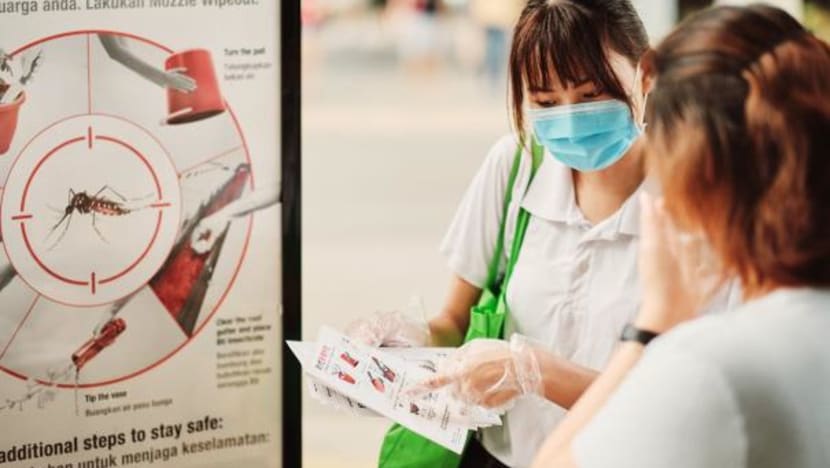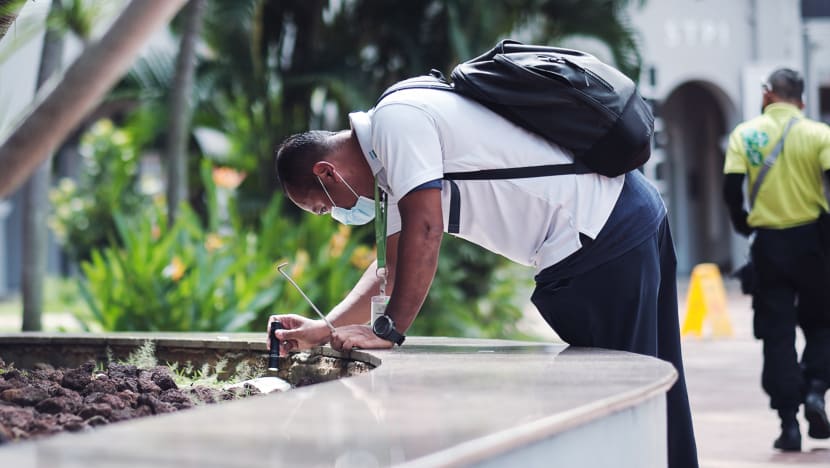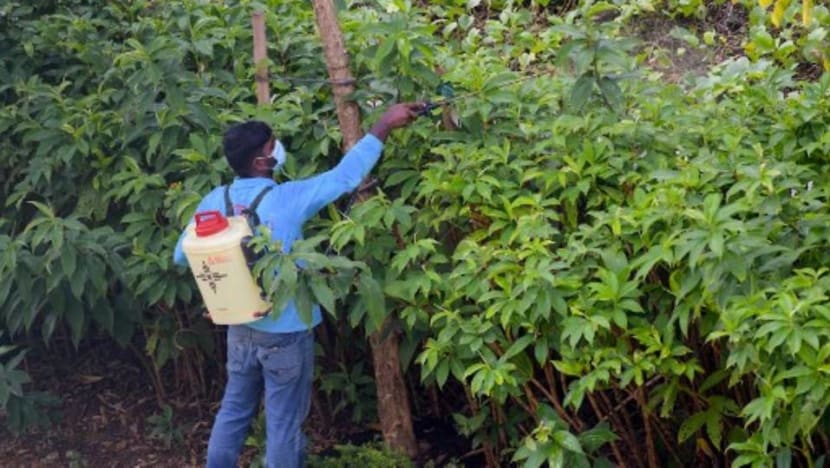commentary Commentary
Commentary: Uncovering the factors fueling record-high dengue cases in Singapore
The circuit breaker contributed to higher dengue numbers for two reasons, say experts at NEA and the Saw Swee Hock School of Public Health.

A member of a pest control team shows a container of mosquito larvae that they collected during their inspection in Singapore on Sep 5, 2016. (File photo: REUTERS/Edgar Su)
SINGAPORE: 2020 will be remembered most of all for the COVID-19 pandemic, which has killed more than a million people and infected countless more worldwide.
But lurking in the shadows of the pandemic is another pestilence, a longstanding public health threat in the tropical and subtropical regions of the globe.
We refer, of course, to dengue, which has infected over 30,000 people in Singapore this year, with more than 1000 cases per week for most of June to August.
This is a historical high, surpassing the highest past record of 22,170 dengue cases in 2013 and highest weekly peak of 891 cases seen in 2014.
EARLY SIGNS
At the beginning of this year, we saw signals of an imminent large dengue outbreak, both in the high number of dengue cases and in the rise in incidence of the uncommon DENV-3 serotype.
READ: Commentary: In Singapore, battling the COVID-19 threat outside and the dengue peril at home
The National Dengue Prevention Campaign was, hence, launched in March by the National Environment Agency (NEA), ahead of the usual launch in May that coincides with the start of the “dengue season”, to mobilise the nation to be conscientious in its housekeeping, get rid of stagnant water, and deprive the Aedes mosquitoes of breeding habitats.
However, despite preventive measures and extensive public communications, weekly reported infection numbers soon exceeded past outbreak trends, suggesting that other factors may have exacerbated the rise.

Dengue transmission intensifies when there is more contact between Aedes mosquitoes and humans, either because of more exposure of people to the bites of Aedes mosquitoes, or an increase in the mosquito population. Could these have been a by-product of our response to the COVID-19 pandemic?
CIRCUIT BREAKER CONTRIBUTE TO THE DENGUE OUTBREAK AS MORE STAYED HOME
The answer is a yes. With more people spending more daytime in naturally ventilated homes, the chance of mosquitoes acquiring the infection from dengue-infected individuals, and then passing it on when they bite healthy individuals, had risen.
This is due to the biology of the Aedes aegypti mosquito, the main vector of dengue. The mosquito is known to bite during the day, peaking at dawn and dusk, rather than at night, and dwell among human habitats.
READ: Commentary: Let Singapore’s green spaces grow wild
In August, NEA and the Saw Swee Hock School of Public Health carried out an epidemiological study to examine the independent effect of the circuit breaker period on the number of reported dengue infections.
We found almost 50 per cent more infections during the circuit breaker period than there should have been based on our modelling. This is even after accounting for the typical surge in dengue cases in the middle of the year and the high baseline level of infection in the first two months of the year.
Most of the excess infections were among adults of working age (20 to 64 years) - people who spent much more of their day at home who would normally have been in offices, factories and shops.

The younger population (5 to 19 years of age) only had 12 per cent more cases, possibly because schools were closed for a shorter period than the entire circuit breaker duration.
Moreover, unlike working adults, school-going children would have spent much of Aedes’ peak biting time of dusk at home even before the circuit breaker.
Exposure to mosquitoes is less likely to change for elders and pre-school children, as they would be spending more time at home even before the circuit breaker period, and therefore they represent a suitable reference population for the analysis.
It’s clear the increased proximity of humans and mosquitoes has fueled a rapid climb in the number of new dengue infections.
CIRCUIT BREAKER MEASURES INCREASED MOSQUITO BREEDING
Despite repeated public communications about the dengue risk, Aedes aegypti mosquito breeding in Singapore increased unabated during the circuit breaker period.
The mean percentage of construction sites inspected found with mosquito breeding from January to March was six per cent. This figure rose three-fold to 18 per cent from April to June, though it has since dropped to about 10 per cent in August.
READ: Commentary: Is swine flu going to be the next pandemic?
This is likely because the suspension of construction activities since the beginning of the circuit breaker period on 7 April 2020, had left construction sites largely unattended and exposed to the tropical weather with regular rainfall.
Furthermore, the lockdown of many of our essential workers to contain COVID-19 transmission in the dormitories had the effect of reducing the frequency of cleaning of public spaces.

The amount of mosquito breeding in homes also continued to be high during the circuit breaker, defying some expectations that individuals spending more time at home would have the capacity to remove stagnant water.
NEA reported a five-fold increase in the incidence of Aedes mosquito larvae detected in homes and common corridors in residential areas during the two-month circuit breaker period compared to the two months prior.
Could the unanticipated increase of mosquito breeding in homes be due to the challenges faced by residents juggling working from home, the higher housekeeping load with more people home, or homemakers having to pay more attention to preparing home-cooked meals and watching over kids who would otherwise be in school?
In recent weeks, though dengue cases have declined for a successive seven-week period, it remains high at 595 last week. As a substantial proportion of our workforce continue to work from home and face a higher risk of acquiring dengue, the fall in dengue cases could thus be long and slow.
READ: Commentary: Record dengue cases complicates Singapore's fight against COVID-19
So far this year, over 20 lives have been lost to dengue, and there may be more unless we collectively take immediate and determined action.
INDIVIDUAL RESPONSES NEEDED TO PROTECT FAMILIES
In the fight against dengue, everyone has a role, because each one of us can become a node for dengue transmission, and the Aedes aegypti mosquito breeds in our homes.
One way to fight dengue is to stop oneself from being bitten. This is especially important for individuals who have dengue, since they are a potential source of the infection for others.
If you live in a dengue high-risk area, you and your family should wear long pants and long-sleeve clothing, and use mosquito repellent to protect against mosquito bites, especially during the Aedes aegypti mosquito’s peak biting periods in the early morning and late afternoon.

You can protect your home by spraying insecticide in the hiding places of the mosquito. These places could be under sofas, tables or shelves, behind curtains, or in dark parts of the kitchen.
Another longer term solution is to install mosquito screens on your windows.
To help remember to check for and remove stagnant water, consider putting a reminder on your phone at a convenient time (such as after dinner) with a two-day repeat.
SOCIETAL RESPONSES NEEDED: TO PROTECT COMMUNITIES
During a large outbreak like this, we must take a communal approach to preventing dengue in our neighbourhoods. Pro-social encouragement in the neighbourhood can help to overcome one of the main barriers to dengue prevention, namely the inertia that comes from a habit of not taking action.
There are inspiring initiatives in the community. For instance, worried by the surge in dengue cases that had infected many people in their neighbourhood, members of an East Coast residential council took proactive efforts to check on residents in their estate, and ensure that they knew how to protect themselves and their families from getting infected.

What makes the COVID-19 pandemic so different from pandemics past is that we have launched an unprecedented response to it—closure of schools, borders, mosques, churches and temples, shops, cinemas, work places, wearing of masks, social distancing, restriction on travel and contact tracing.
As a society, we have done more to stop COVID-19 spread than for any other disease in recent times.
READ: Commentary: Why risk of contracting COVID-19 may be higher in some places
The response, both how we have accepted these and how the pandemic has so far been kept in check, shows what can be achieved when we work together to contain a public health threat.
Associate Professor Alex Cook is the Vice Dean of Research at the Saw Swee Hock School of Public Health, National University of Singapore.
Associate Professor Ng Lee Ching is the Group Director of the Environmental Health Institute at the National Environment Agency. She has provided expert advice to the World Health Organization.















